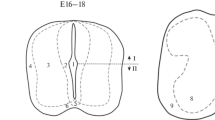Summary
The brains of 93 rats (of between the last week of pregnancy up to the 30th postnatal day) were investigated by means of light and electron microscopy.
At the end of the second week of pregnancy, subependymal cells, the cytoplasm of which is blue after staining with a periodic-acid-bisulfit-aldehydethionine-method, begin to appear in the middle part of the IIIrd ventricle. After birth, the blue cells can also be demonstrated in other parts of the IIIrd ventricle as well as in the wall of aquaeduct and the IVth ventricle. The cells are exclusively found in a loosely textured subependymal tissue. Between the 14th and the 17th day the number of the blue cells decreases and around the 22nd postnatal day they disappear completely. Simultaneously, the texture of the subependymal tissue becomes more compact.
The blue cells can be identified by electron microscopy. They are characterized by the presence of several processes and contain many mitochondria, different sized vacuoles and cytosomes. The cell processes enclose subependymal cavities containing a loose flocculose material. The cells are considered as microglia cells. Their function is considered in relation to the disappearance of the loose texture of the subependymal zone.
Zusammenfassung
Die Gehirne von 93 Ratten (letzte Embryonalwoche bis zum 30. postnatalen Tag) wurden licht- und elektronenmikroskopisch untersucht.
Am Ende der zweiten Embryonalwoche treten im mittleren Teil des III. Ventrikels Zellen auf, deren Cytoplasma sich mit einer Perjodsäure-Bisulfit-Aldehydthionin-Methode blau anfärben läßt. Die blauen Zellen werden nach der Geburt auch an anderen Abschnitten des III. Ventrikels sowie am Aquaedukt und IV. Ventrikel ausschließlich in einer lockeren subependymalen Gliazone gefunden. Zwischen dem 14. und 17. Tag nimmt ihre Zahl ab, um den 22. postnatalen Tag sind die blauen Zellen völlig verschwunden. Gleichzeitig wird die subependymale Auflockerungszone dichter.
Elektronenmikroskopisch werden die blauen Zellen als fortsatzreiche Elemente identifiziert, die viele Mitochondrien und unterschiedlich große Vacuolen und Cytosomen enthalten. Die Fortsätze umschließen subependymale Räume, die ein feinflockiges Material enthalten. Die Zellen werden als mikrogliäre Elemente angesehen, ihre Funktion mit dem Verschwinden der subependymalen Auflockerungszone in Verbindung gebracht.
Similar content being viewed by others
Literatur
Bolsi, D.: Il problema della origine della microglia. Riv. Pat. nerv. ment. 48, 1–128 (1936)
Booz, K. H., Desaga, U., Felsing, T.: Über die postnatale Entstehung der Basalmembranlabyrinthe am Ventrikelsystem der weißen Ratte. Z. Anat. Entwickl.-Gesch. (im Druck)
Booz, K. H., Desaga, U., Felsing, T., Franz, H., Stark, M.: Sub- und interependymale Basalmembranlabyrinthe am Zentralkanal der weißen Ratte. Z. Zellforsch. 132, 217–229 (1972)
Del Rio Hortega, P.: El “tercer elemento” de los centros nerviosos. I. La microglia en estado normal. II. Intervención de la microglia en los procesos pathológicos. III. Naturaleza probable de la microglia. Bol. Soc. esp. Biol. 9, 69–120 (1919)
Desaga, U.: Über Faltungen der Kernmembranen (Kernschrumpfung) des Ependyms im III. Ventrikel der Ratte nach langdauernder intraperitonealer Narkose mit Natrium-5-(β-Methylthioäthyl)-5-(2-penthyl)-thiobarbitursäure (“Thiogenal”). Acta neuropath. (Berl.) 16, 44–53 (1970)
Desaga, U.: Form und Verteilung subependymaler Basalmembranlabyrinthe am Ventrikel-system der Ratte. Z. Zellforsch. 132, 553–562 (1972)
Fleischhauer, K.: Fluoreszenzmikroskopische Untersuchungen an der Faserglia. I. Beobachtungen an der Wand der Hirnventrikel der Katze (Seitenventrikel, III. Ventrikel). Z. Zellforsch. 51, 467–496 (1960)
Fleischhauer, K.: Über die postnatale Entwicklung der subependymalen und marginalen Gliafaserschicht im Gehirn der Katze. Z. Zellforsch. 75, 96–108 (1966)
Fleischhauer, K.: Über den Bau der Wandung des Aquaeductus cerebri und des IV. Ventrikels der Katze. Z. Zellforsch. 88, 113–125 (1968)
—: Postnatale Entwicklung der Neuroglia. Acta neuropath. (Berl.), Suppl. IV., 20–32 (1968)
Fleischhauer, K.: Über die postnatale Entwicklung des Stratum subcallosum im Vorderhorn des Seitenventrikels der Katze. Z. Anat. Entwickl.-Gesch. 132, 1–17 (1970)
Hillebrand, H.: Quantitative Untersuchungen über postnatale Veränderungen der Glia im Corpus callosum der Katze. Z. Zellforsch. 73, 303–312 (1966)
Juba, A.: Untersuchungen über die Entwicklung der Hortegaschen Mikroglia des Menschen. Arch. Psychiat. Nervenkr. 101, 577–592 (1933)
Kershman, J.: Genesis of microglia in the human brain. Arch. Neurol. Psychiat. 41, 24–50 (1939)
Lentz, T. L.: Cell fine structure. Philadelphia-London-Toronto: Saunders Co. 1971
Leonhardt, H.: Über die topographische Verteilung der subependymalen Basalmembranlabyrinthe im Ventrikelsystem des Kaninchengehirns. Z. Zellforsch. 127, 392–406 (1972)
Leonhardt, H.: Subependymale Basalmembranlabyrinthe. Anat. Anz., Erg.-Bd. (im Druck)
Mori, S., Leblond, C. P.: Identification of microglia in light- and electron microscopy. J. comp. Neurol. 135, 57–80 (1969)
Penfield, P.: Microglia and the process of phagocytosis in gliomas. Amer. J. Path. 1, 77–89 (1925)
Rydberg, E.: Cerebral injury in new-born children consequent on birth trauma; with inquiry into the normal and pathological anatomy of the neuroglia. Acta path. microbiol. scand., Suppl. 10, 1–247 (1932)
Santha, K., Juba, A.: Weitere Untersuchungen über die Entwicklung der Hortegaschen Mikroglia. Arch. Psychiat. Nervenkr. 98, 598–613 (1933)
Specht, W.: Färben mit Aldehydthionin. Eine Methode für den topochemischen Nachweis von Sulfonsäure und Aldehyden. 65. Verslg. Anat. Ges. Würzburg, 1970. Demonstration (und Mündliche Mitteilung)
Stensaas, L. J., Reichert, W. H.: Round and amoeboid microglial cells in the neonatal rabbit brain. Z. Zellforsch. 119, 147–163 (1971)
Vigh, B.: Das Paraventrikularorgan und das zirkumventrikuläre System des Gehirns. Studia Biologica Academiae Scientiarum Hungaricae, Bd. 10. Budapest: Verlag der ungarischen Akademie der Wissenschaften 1971
Author information
Authors and Affiliations
Additional information
Mit dankenswerter Unterstützung durch die Deutsche Forschungsgemeinschaft (Le 69/7).
Rights and permissions
About this article
Cite this article
Booz, K.H., Felsing, T. Über ein transitorisches, perinatales subependymales Zellsystem der weißen Ratte. Z. Anat. Entwickl. Gesch. 141, 275–288 (1973). https://doi.org/10.1007/BF00519048
Received:
Issue Date:
DOI: https://doi.org/10.1007/BF00519048



